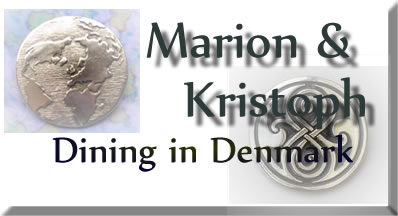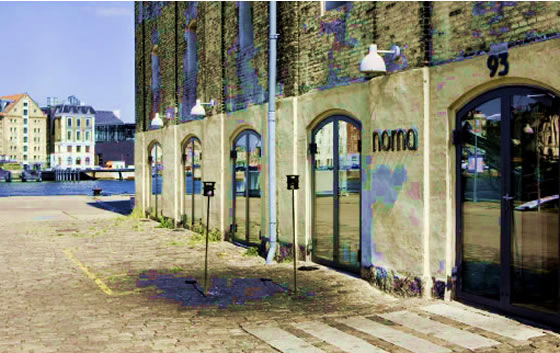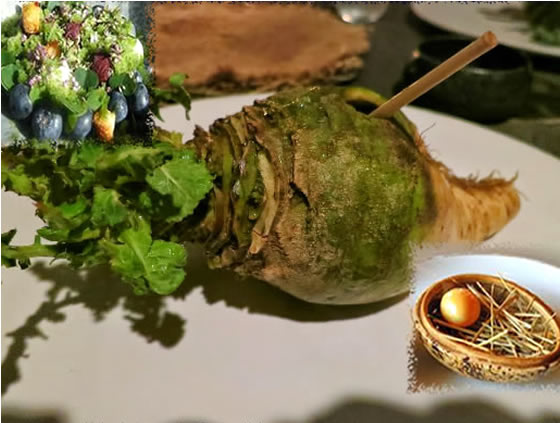

The TARDIS had been fully repaired, and Marion was perfectly confident in its ability to get them where they wanted to go without mishap. So much so that she invited Hillary and Jean-Claude to join them on their evening away from Gallifrey.
Actually, it turned out to be Hillary and Claudia Jean, both in female form. Hillary was in a smart grey silk skirt suit and Claudia-Jean in a figure hugging red dress. Marion chose pale green satin to emulate them for style. Kristoph was dashing in a dark grey suit.
Marion had chosen to visit Earth. Kristoph had chosen the venue. He told them that they were visiting the best restaurant on the planet.
“Do people actually vote on such a thing?” Marion asked as they stepped out of the TARDIS into what had once been a part of Copenhagen’s thriving port, but was now gentrified waterside property.
“Apparently they do,” Hillary observed. “Though I didn’t know Kristoph was interested in such things.”
“I read a review of this place and was intrigued by their unique menu,” he explained. “I think you’ll all be surprised.”
The restaurant, called Noma, a portmanteau word from ‘Nordic’ and ‘mad’ - Danish for ‘food’, was a former warehouse, evidenced by the stone walls and small high windows of the outside and the exposed roof beams inside. The party of four were met by their waiter for the evening and showed to a table where champagne was served in an ice bucket. While they drank their aperitif they studied the menu.
“I don’t understand this at all,” Marion conceded, laying down the printed bill of fare. “I don’t mean because it’s written in Danish, but because it just lists about twenty things… I don’t know if they’re starters or main courses or whatever. How on Earth do we choose what to eat?”
“We don’t,” Kristoph explained. “This restaurant specialises in Nordic food served in small portions, one after the other. THAT is the meal we’re eating.”
And just then the first course was brought to the table. Marion looked at the bowl made of some kind of black stone containing a bunch of redcurrants dusted with salt, green strawberries marinated in balsamic vinegar and sprigs of lavender. Her first thought was which piece of cutlery to eat it with. She had learnt the right forks for at least fifty different kind of food, but this one had her beat until Kristoph indicated a set of cocktail sticks by the side of the dish which were used to skewer and pick out the fruits.
It was a strange dish, a combination of sweet, salt and sour that played with all three taste senses. They had barely finished when the second dish arrived. Everyone around the table looked at it with levels of bemusement. It looked like a raw turnip, complete with leaves. There was a hole in the side through which was stuck an organic straw made of vegetable leaves.
“Nordic coconut,” the waiter explained. “Hollowed out Kohlrabi filled with a delicious broth of mushrooms, cabbage and caraway seed.”
The broth was drunk through the ‘straw’ which added its own flavour to the warm mixture of tastes. Just HOW to drink it was the question. Marion tried bending over the plate to reach the straw, but in the end followed everyone else by picking up the cool-sided vegetable ‘flask’ to drink its contents.
With the ‘soup course’ they were served a cool glass of kohlrabi and pear juice. The combination was unusual but not unpleasant. Meanwhile the next dish was brought to the table.
Even Kristoph, who had been philosophical up until now, stared at what looked more like a children’s nature project than something they were meant to eat. Marion checked the menu and discovered that this was called Moss and Cep. The waiter explained that this was reindeer moss fried in aromatic oil and dusted with powdered and dried cep – a mushroom sometimes known as porcini. It was served with a cool crème fraische side dish.
And though it looked strange, and Kristoph didn’t help matters by pointing out that it was called reindeer moss because it was a fodder food usually eaten by the animals, it actually tasted pleasant.
“It’s a lot like the fried seaweed we eat in the Welcome Friend,” Marion said about the moss. “And the powdered mushroom is delicious. I just can’t get over how it all LOOKS! It seems as if Nordic people have found things to eat that most of us would never even consider edible.”
“Imagine what the first man to eat an oyster must have thought!” Kristoph commented. “And just how hungry he must have been before resorting to such an unappetising thing.”
Marion laughed. She had eaten oysters many times, both fresh from the shell and in various cooked delicacies. She accepted that they were edible. Perhaps she just had to be more open minded.
She applied that philosophy to the next courses – flower tarts – actual edible flowers on a seaweed pastry – because ordinary pastry would be too easy, perhaps; peas and radishes in a creamy sauce – the easiest dish to recognise; pickled and smoked quails eggs served in an actual bird’s nest.
Then there was flatbread with wild roses – the bread was malted and the rose petals just like a salad leaf. Marion thought about the rose garden she loved, where she had eaten many summer lunches, but never once thought of eating the roses themselves.
White cabbage with samphire was actually a kind of salad Marion had eaten before in some of her favourite restaurants on Earth and on Gallifrey. The sautéed cabbage slices were so thin it was nearly transparent. The shoots of samphire with their natural sea salt flavour were sandwiched between them.
But the next course was a little less easy to swallow. It looked like florets made of strips of thin meat, and was described on the menu as caramelized milk and monkfish liver. It was seasoned with seaweed salt which made it palatable, but Marion summed up her feelings about it as the plates were taken away afterwards.
“I wish they hadn’t TOLD me it was fish liver,” Marion said. “I think I could have enjoyed it more not knowing that. I just can’t get away from the thought of cod liver oil.”
The next part of the meal was less problematic. On the menu it said Æbleskiver, lovage and parsley. Everyone was a little wary of what an Æbleskiver might be, half expecting some kind of ferocious looking fish or half of a duck.
They were relieved to see a kind of spherical pancake or dumpling with a savoury filling and the lovage and parsley studding the outside.
But then the more unusual tastes arrived again with burnt leek and cod roe, a sort of Nordic dolmades and poor man’s caviar. The burnt outside made them crispy and wasn’t as unpleasant as it sounded.
And that represented the end of the ‘starter’ dishes. Now came the main courses. They started with something that had worried Marion at first – shrimp and goosefoot in radish and yeast sauce. Goosefoot surely didn’t mean what it seemed to mean?
To her relief, it didn’t. Goosefoot was another green vegetable whose leaves were sealed around the shrimps to make little packages that floated in the savoury sauce.
The next course, white asparagus, blackcurrant leaves and some fragrant little yellow flowers were pleasingly arranged and covered in a barley sauce. Again, though, this was not most obviously edible selection of greenstuff and a question arose in Marion’s thoughts. She put it to the waiter after he had poured the wine and fruit juice that accompanied this dish.
“This is quite expensive haute cuisine,” she said. “But does it originate from something terrible like people having to eat weeds found in the fields because of some kind of famine or disaster?”
“No, madam,” the waiter assured her. “It is simply that our cuisine has always included more unusual ingredients.”
She was reassured. This selection of unusual tastes, served as it was in small but frequent portions, was surprisingly filling, but she had visions of hungry people trying to gather enough moss and leaves to keep themselves from starvation that threatened to spoil her appetite.
“You are a sensitive soul, Marion,” Claudia-Jean told her. “Even if there was some historical reason for eating these unusual foods, there is no reason for you to feel guilty about it, now.”
“Quite right,” Kristoph agreed. “After all, how many potatoes have you eaten without feeling guilty about the Irish potato famine?”
That was certainly true. But having regained her zest for this unusual cuisine, Marion was rather less enchanted by the next main course dish. She stared at the unappetising plate put in front of her and then listened to the waiter explain why beef tartar laced with ants was one of the most famous dishes from the celebrated restaurant.
“The fresh beef is minced and mixed with capers and balsamic vinegar as well as a selection of spices to enhance the flavour of the meat. The freeze dried ants, rolled in sea salt provide an acidic complement to the taste as there is no naturally growing source of citric flavouring in the Nordic countries.”
Marion said nothing. She watched as her husband and her two friends took large forkfuls of raw beef and ants.
“I really don’t like raw beef,” she said as she took a very small portion of the meat without the ants. The flavour was not completely unpalatable to her, but she couldn’t get over the fact that it was uncooked.
“You really should try it WITH the ants,” Hillary told her. “The taste is surprising.”
She tried it. The sharply acidic and salty taste did contrast well with the meat. She shook her head in astonishment.
“I’ve just eaten a freeze dried ant with a forkful of raw beef,” she said. “I never in my life imagined I would do such a thing… and certainly not at something voted as the best restaurant in the world.”
“Live ants would certainly leave any food establishment stripped of its reputation,” Kristoph agreed. “But this is DIFFERENT.”
“Beef tartar is a specialty in many Haolstromnian restaurants,” Claudia Jean noted. “The ants are unusual, but not unpleasant. I might even suggest it as an accompaniment to the dish sometime.”
Hillary laughed and advised her partner not to put it on the menu at the inauguration ball when she was sworn in as president for her second term.
“I don’t think I could persuade our cook to prepare it,” Kristoph admitted. “And our butler would be scandalised to serve it. We shall have to come back here to enjoy the experience again.”
There was a flash of humour in his eyes. Marion looked at him accusingly.
“You KNEW about this part of the menu, didn’t you? And you knew how I would react.”
“I think you are doing splendidly, my dear,” Kristoph responded. He looked around pointedly at another dinner guest, obviously not one who could read the Danish menu. She was swooning in horror and demanding that the waiter take the plate away. “Certainly you are behaving quite diplomatically.”
“I don’t think I can finish this dish, though,” she admitted. “It’s not the ants I dislike as much as the raw beef. It makes me gag. I will apologise to the waiter when he returns.”
The waiter was obviously used to people having problems with the beef tartar and took her apology gracefully. As she drank cool apple and pomegranate juice to clear the taste from her mouth he brought the next dish to the table. The small but elegantly presented portion of beetroot in a sauce of sloe berries and aromatic herbs didn’t taste anything like the pickled beetroots from a jar that Marion had known most of her life and the taste surprised her.
“I know I sound very common,” she admitted. “But I really didn’t know you could do anything else with beets except slice and pickle them. THIS recipe you CAN pass on to our cook.”
“It would be difficult,” Kristph admitted. “Beets are not native to Gallifrey and getting permission to import them would be too much trouble. We really ARE going to have to come back to Noma another time.”
Another salad dish followed – cured egg yolk and potato on a bed of elderflower. Perhaps it was the aftermath of more exotic ideas, but this didn’t find favour with anyone around the table. It was just a little bland.
“Perhaps a few ants to spice it up….” Hillary suggested with a wicked smile.
“The radish and yeast sauce from a couple of dishes back drizzled over it would have made it a little less dry,” Marion said.
“And an ant or two,” Claudia Jean added, joining in with her partner’s humour. Marion conceded that a little acidic tang wouldn’t be a bad thing as they readied themselves for the last of the main courses.
This was a surprisingly ‘normal’ looking dish – a piece of poached white fish – turbot. But it was flavoured with nasturtium, another flower Marion had never imagined as a foodstuff, and served on a bed of wood sorrel with a spoonful of thickened cream.
“Now for the dessert courses,” Kristoph announced. “No insects involved. I can assure everyone of that.”
But if anyone expected the desserts to be any less unusual than the other courses, they were quite wrong. Rhubarb and sorrel with crème fraiche and Spanish chervil was the first sweet dish to be brought. The sorrel was made into a deep green sauce base on which a dollop of crème fraiche was sprinkled with chervil, before a portion of rhubarb artistically made into the shape of a rose was placed on top.
“Rhubarb shaped like roses, rose petals on bread. Everything is unexpected, here.” Claudia Jean summed it up as they enjoyed the delicate sour-sweet tastes.
That was followed by a second dessert, a much sweeter one, called Gammel Dansk. The name of the dessert came from the liquor which was poured onto the plate before a liberal portion of cream, crisp pieces of meringue and a sprinkling of chopped sorrel.
Which concluded the formal dishes, and the party were invited to move from the main restaurant to the separate bar where coffees and liquors were served with a selection of delicacies such as salted potato crisps coated with chocolate and dipped in cream, marshmallows and caramels, deliciously warm Danish pastries and one very peculiar – and possibly the most fattening confectionary of all - pieces of deep fried pork coated in chocolate.
“Now THIS I would go to the trouble of getting an import licence for,” Kristoph declared after tasting that delicacy. Marion disagreed, preferring a light, airy marshmallow treat. Their two friends couldn’t decide and moved around tasting samples of all of the after-dinner treats and flirting shamelessly with other diners.
“A wonderful evening,” Marion declared. “Except for the beef tartar. With or without ants I don’t think I can learn to like that.”
Kristoph smiled and helped himself to another helping of deep fried pork in chocolate, reminding himself that his Gallifreyan metabolism could easily absorb the outrageous calorie intake involved in such a snack.

 |
 |
 |